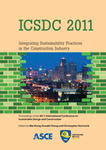Design Standards for Converting Unused Railway Lines into Greenways
Publication: ICSDC 2011: Integrating Sustainability Practices in the Construction Industry
Abstract
The gradual increase in private mobility, dating back to the second half of the last century in western countries, especially in Italy, has caused the shutdown of several secondary railway lines which are rarely used and therefore little profitable to any institution, either owner or manager. Today the disused road patrimony can be functionally upgraded through conversion of railways into greenways dedicated to the so-called "soft mobility" (i.e. walking and cycling routes), thanks to the following features: i) separation of railway sediment from the ordinary road network; ii) reduced number of intersections with the road network; iii) moderate longitudinal slopes, generally less than 35߮; iv) long straight roads and large horizontal radii; v) width compatibility between the railway platform and that for cyclists and pedestrians; vi) interconnection between urban centres and routes passing often through areas of great natural value, hardly accessible by alternative modes of transport; vii) link with other public transport services. Moreover, since the majority of the disused railway infrastructures is publicly owned, the community is as a rule inclined to accept their conversion into greenways. In some Italian regions, such as Basilicata, Sicily and Sardinia, narrow-gauge railway lines (950 mm) were in the past highly used for orographic, economic and technical reasons, but they are now completely obsolete; a real greenway network can well be built in such contexts. With reference to Sicily, narrow-gauge lines covered approximately 811 km, of which 563 km have been managed by national railways and 248 km given to private companies since 1905. In the light of such potential, on 6 June 2006 the Sicilian Region issued a city council decree on the non-motorized mobility in Sicily, later enforced, as regards the conversion of railway sediments into greenways, by implementing the regional strategic plan for soft and/or non-motorized mobility, i.e. cycle and pedestrian routes called greenways (year 2009); the plan provided for approximately 16.5 million euros to be called for tenders in order to finance the realization of "main", "secondary" and "dedicated" suburban greenways. In this paper, after briefly reviewing the main international and Italian experiences in upgrading old disused railways and after examining some environmental issues closely linked to their construction, we indicate the major design standards and the technical measures required to make their plano-altimetric geometry in line with the national and international technical design standards for cycle tracks.
Get full access to this article
View all available purchase options and get full access to this chapter.
Information & Authors
Information
Published In
Copyright
© 2012 American Society of Civil Engineers.
History
Published online: Apr 26, 2012
Authors
Metrics & Citations
Metrics
Citations
Download citation
If you have the appropriate software installed, you can download article citation data to the citation manager of your choice. Simply select your manager software from the list below and click Download.
